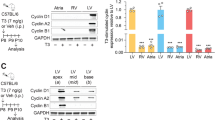Abstract
Adult rat cardiomyocytes (ARC) isolated from ventricles follow a defined sequence of structural remodeling during culturing for 2–3 weeks. Rod-shaped cells round up, attach to the substratum, and start growing out in all directions until they form contacts with one another and resume rhythmic contractile activity. In general, myofibrils redevelop along the actin scaffold into the periphery. IGF-I enhances this process while bFGF restricts the outgrowing of myofibrils to the central cell area. Presence of T3 in the culture medium also restricts myofibrillar growth like bFGF. At the same time, T3 increases spontaneous beating frequency in a dose-dependent manner. With 10 nM T3 beating frequency is increased three-fold versus control. Addition of isoproterenol or of epinephrine further increases the frequency at all T3 concentrations tested. Propranolol inhibits the fully stimulated beating frequency to about the same extent at all T3 concentrations. Therefore, T3 seems to determine the beating frequency of ARC in culture directly and not by changing the composition of the adrenoceptor population nor by changing their responsiveness.
Similar content being viewed by others
Author information
Authors and Affiliations
Additional information
Received: 10 April 1997, Returned for 1. revision: 28 May 1997, 1. Revision received: 18 June 1997, Accepted: 20 June 1997
Rights and permissions
About this article
Cite this article
Schaub, M., Hefti, M., Harder, B. et al. Triiodothyronine restricts myofibrillar growth and enhances beating frequency in cultured adult rat cardiomyocytes. Basic Res Cardiol 93, 391–395 (1998). https://doi.org/10.1007/s003950050107
Issue Date:
DOI: https://doi.org/10.1007/s003950050107




